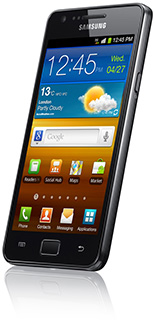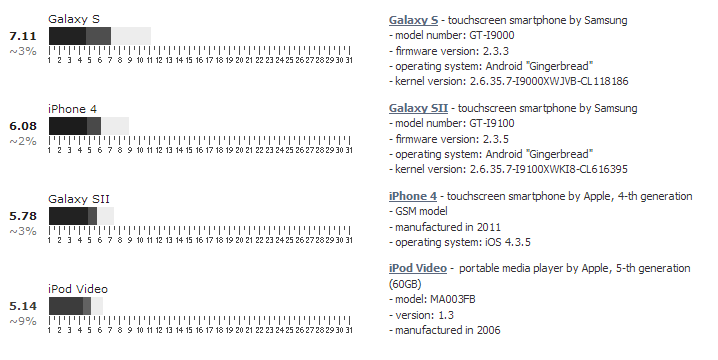Published Date 6/9/12 8:32 PM
This article is obsolete and retained for archival purpose. Listening tests of portable players are no-longer conducted and substituted by objective measurements which are available on portable players page -
http://soundexpert.org/portable-players. The measurements of Galaxy SII was not performed due to its low popularity these days.
 |
| Galaxy SII
smartphone by Samsung |
The second iPhone-killer from Samsung - Galaxy SII (GT-I9100, Android "Gingerbread") was added to SE rating system, "Portable players" section. Unlike its predecessor it uses Yamaha audio chip (Galaxy S features Walfson one) which is considered to be of inferior audio quality. Our main conclusions are:
- Distortions of various audio signals are low (see Table 1), they are comparable with the values for other players of this class
- There is some oddity in reproduction of pure sine wave (see Audio 1) but the level of the distortion is perfectly low
- Music passages with high macro-dynamics and pronounced stereo effects are a problem for Galaxy SII integrated headphones amplifier (see Audio 2)
- Final conclusion about Galaxy SII audio quality can be made only after finishing of listening tests which are integral part of SE audio metric; consider taking part in SoundExpert tests
Objective measurements
Difference levels for our standard set of signals and samples are in the table below:
Table 1: Difference levels of signals and samples transferred through Galaxy SII.
The values show how much output waveforms differ from input ones (-∞ dB: perfectly similar, 0 dB: totally different).
Sine@1kHz
88dB SPL | White noise
88dB SPL | J.S.Bach
82dB SPL | Bass
83dB SPL | Castanets
80dB SPL | French male speech
84dB SPL | Glockenspiel
77dB SPL | Harpsichord
79dB SPL | Postscriptum
80dB SPL | Mike Oldfield
83dB SPL | Quartet
85dB SPL |
| -67.38 (L) | -20.83 (L) | -24.87 | -26.58 | -28.10 | -27.85 | -33.31 | -19.49 | -20.41 | -11.85 | -29.59 |
| -67.54 (R) | -20.88 (R) |
The values look promising especially in case of white noise. The level of sine signal distortion is low but the nature of its distortion is unexpectedly strange:
Download this Audio in lossless format FLAC:750kB
Audio 1 Sinusoidal signal (@1kHz, 88dB SPL unweighted) at the output of Galaxy SII with sound artifacts amplified to +67dB.
The origin of that modulation is unclear but its level is pretty low to provoke any serious audible consequences on real life audio material.
Sound flavoring
One of SE test samples revealed another weakness of Galaxy SII audio. In the Table 1 "Mike Oldfield" sample has relatively high level of distortion -11.85dB. The sample contains independent "sound bursts" in each stereo channel which easily penetrate into neighboring channel with different phase shifts mostly inverted. To demonstrate the results of such occasional cross-talk we prepared "artificial stereo" recording of "Mike Oldfield" sample as we did that previously for Galaxy S. Left and right channels were played back and recorded separately (sequentially) and combined later in stereo track. Resulting "artificial stereo" doesn't suffer from any cross-talks and can be compared with the usual stereo recording. For the ease of comparison sound artifacts of both recordings were amplified to +15dB and the reference sample is added at the beginning:
Download this Audio in lossless format FLAC:2.68MB
Audio 2 Three sound samples show the consequences of occasional cross-talk in Galaxy SII. First sample is a reference one. Second – played back by Galaxy SII without cross-talk (left and right channels were recorded separately). Third sample was played back and recorded in stereo normally thus it is affected by cross-talk. Sound artifacts of two last samples were amplified to +15dB making the difference between samples more audible.
The "artificial stereo" sample shows only lack of mid-high frequencies which is normal at this level of artifacts amplification - almost all audio equipment loaded with real load has some gradual cut of highs. The third "normal stereo" sample has a lot of highs penetrated from neighboring channel with varying phase shifts making the whole sound picture look like being processed by low bitrate encoder. Additional research revealed that such cross-talk occurs only in rare cases. Most audio material sounds the same in "normal stereo" and "artificial stereo" recordings. So the only problem is the music with high macro-dynamics and pronounced stereo effects. Such combination is common for electronic music. Taking into account that the above weakness become noticeable at relatively small artifacts amplification (+5dB) we can conclude that most dramatic parts of such music will be slightly smeared for sure.
As the above cross-talk occurs only during fast and loud sound transients, the most probable origin of this is headphones amplifier.
***
SoundExpert kindly thanks Galina for possibility to make all necessary recordings on her Galaxy SII smartphone.
As usually SoundExpert reminds you that final conclusion about audio quality of any device added can be made only after completing of SE listening tests and any technical parameters could be misleading when evaluating perceived sound quality. So we encourage you to take part in our listening tests. All SE ratings, including Galaxy SII one, exist only thanks to visitors like you. Testing is short and easy, visit our Testing Room for simple 1-2-3 instruction.
Please, remember, downloading a test file from SoundExpert you will not necessarily get a test file of Galaxy SII. SoundExpert testing is blind testing – you don't know the device you test. This is the only reliable way of getting true audio quality ratings, free from any cheating and various human senses other than perception of sound quality. After you have sent your grade you will see the device you tested.
Best regards,
SE Team.
Update. 2015 August 22
Deprecated results of previous listening test of Portable Players. For archival purposes only.
